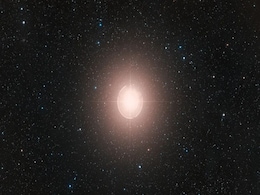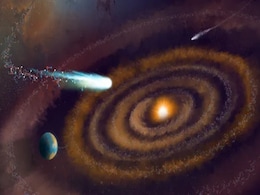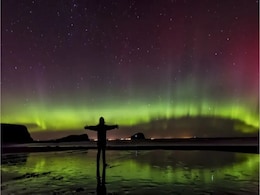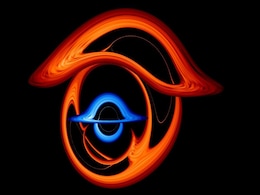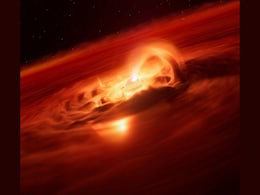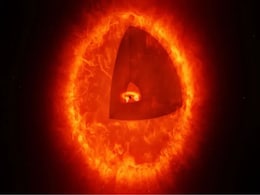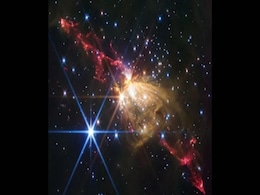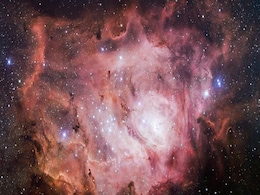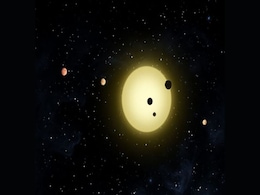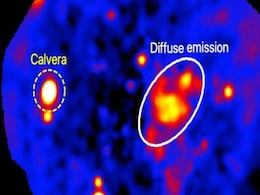Astronomical Discoveries
- All
- News
-

Astronomers Capture First-Ever Early Snapshot of Supernova Shock Wave Using ESO’s VLT
- Monday November 17, 2025
- Written by Gadgets 360 Staff
Astronomers using ESO’s Very Large Telescope have captured a rare early look at supernova SN 2024ggi, just one day after its discovery. The blast shockwave appeared olive-shaped—not spherical—revealing surprising asymmetry in the explosion. Recorded with the FORS2 instrument, the data shows the shock-breakout phase in unprecedented detail. Th...
-
 www.gadgets360.com
www.gadgets360.com
-

Nearby Super-Earth GJ 251 c Could Help Learn About Worlds That Once Supported Life, Astronomers Say
- Sunday November 16, 2025
- Written by Gadgets 360 Staff
Astronomers discovered GJ 251 c, a super-Earth 20 light-years away. Its location in the habitable zone and rocky composition make it a top candidate for future searches for life beyond our solar system. The team, led by Suvrath Mahadevan and Corey Beard, said this discovery provides a clock for one of the best candidates to search for life's atmo...
-
 www.gadgets360.com
www.gadgets360.com
-

Webb Finds Phosphorus-Bearing Gas in an Ancient Brown Dwarf
- Monday November 10, 2025
- Written by Gadgets 360 Staff
NASA’s James Webb Space Telescope has detected phosphine (PH₃) in the atmosphere of the ancient brown dwarf Wolf 1130C, about 54 light-years away in Cygnus. This marks the first confirmed detection of a phosphorus-bearing gas in such a metal-poor object. The finding surprises astronomers, as phosphine was previously undetected in similar brown ...
-
 www.gadgets360.com
www.gadgets360.com
-

NASA Telescopes Capture First-Ever Companion Star Orbiting Massive Red Supergiant Betelgeuse
- Sunday October 26, 2025
- Written by Gadgets 360 Staff
Astronomers have detected a small companion star orbiting the red supergiant Betelgeuse using Hubble and Chandra observations. Dubbed “Betelbuddy,” the discovery reveals an extreme binary system that challenges existing models of stellar evolution and may offer clues to Betelgeuse’s future.
-
 www.gadgets360.com
www.gadgets360.com
-

Astronomers Detect Heavy Water in Planet-Forming Disk Around Young Star
- Monday October 20, 2025
- Written by Gadgets 360 Staff
Scientists have detected heavy water in the planet-forming disk around young star V883 Orionis, confirming the water existed long before the star formed. The discovery, made using ALMA, shows that water’s origins trace back to ancient interstellar clouds, linking molecular gas, comets, and planetary systems across billions of years.
-
 www.gadgets360.com
www.gadgets360.com
-

Astronomers Discover Most Distant And Powerful Odd Radio Circle In The Universe
- Wednesday October 15, 2025
- Written by Gadgets 360 Staff
A rare discovery in deep space has stunned astronomers: twin radio rings surrounding a galaxy about 7 billion light-years away. Known as an odd radio circle (ORC), this is the most distant and powerful ever found. Citizen scientists first spotted it, and LOFAR confirmed its existence, opening new insights into galactic and black hole evolution.
-
 www.gadgets360.com
www.gadgets360.com
-

Astronomers Capture First Image of Two Supermassive Black Holes Orbiting Each Other
- Tuesday October 14, 2025
- Written by Gadgets 360 Staff
Astronomers have captured the first image of two supermassive black holes orbiting in quasar OJ 287. The smaller black hole’s jet spirals due to gravitational forces from the larger one. This discovery validates dual-core theories and opens doors for research on gravitational waves and galaxy evolution.
-
 www.gadgets360.com
www.gadgets360.com
-

Astronomers Capture First-Ever Image Of A Baby Planet Forming In Real Time
- Tuesday October 7, 2025
- Science | Edited by Nikhil Pandey
Astronomers have made a groundbreaking discovery by directly observing a young protoplanet, WISPIT 2b, embedded in a ring-shaped gap in a disk around a young star.
-
 www.ndtv.com
www.ndtv.com
-

Astronomers Spot Rapidly Growing Rogue Planet Feeding on Surrounding Gas
- Sunday October 5, 2025
- Written by Gadgets 360 Staff
Astronomers have discovered that Cha 1107-7626, a rogue planet 620 light-years away, is now the fastest-growing planet ever observed. The massive world consumes six billion tonnes of gas per second, a rate never before recorded. The findings suggest rogue planets can grow in star-like ways, reshaping how scientists view free-floating planetary obje...
-
 www.gadgets360.com
www.gadgets360.com
-

NASA’s James Webb Telescope May Have Found First Black Hole Star, Known as ‘The Cliff’
- Thursday September 25, 2025
- Written by Gadgets 360 Staff
JWST detected “The Cliff,” a candidate black hole star with a black hole core wrapped in a luminous gas shell. This discovery offers insights into black hole formation, stellar evolution, and cosmic dynamics, prompting astronomers to search for similar objects across the universe.
-
 www.gadgets360.com
www.gadgets360.com
-

James Webb Space Telescope Spots Rare Protostar Blasting Twin Jets Across Milky Way
- Friday September 12, 2025
- Written by Gadgets 360 Staff
NASA’s James Webb Space Telescope has captured a rare protostar about ten times the Sun’s mass blasting twin jets nearly eight light-years long. The beams carve through the glowing Sharpless 2-284 nebula, offering astronomers a vivid glimpse into how massive stars form and shape their galactic environment.
-
 www.gadgets360.com
www.gadgets360.com
-

Universe’s First Stars May Have Been Smaller Than Astronomers Once Believed
- Tuesday September 9, 2025
- Written by Gadgets 360 Staff
Astronomers once thought the universe’s first stars were only massive giants. New simulations and lab experiments reveal turbulence and early chemistry allowed smaller, Sun-like stars to form too. This discovery reshapes our view of cosmic dawn, showing the first stellar generation was more diverse than previously believed.
-
 www.gadgets360.com
www.gadgets360.com
-

Exoplanets Explained: How Astronomers Find Worlds Orbiting Stars Beyond the Sun
- Monday September 8, 2025
- Written by Gadgets 360 Staff
Exoplanets are planets orbiting stars outside our solar system, hidden by stellar glare and detected indirectly. Astronomers identify them by tracking star wobbles or dips in brightness during planetary transits. NASA’s Kepler mission revealed thousands, with TESS now expanding the search. These discoveries confirm that planetary systems are abun...
-
 www.gadgets360.com
www.gadgets360.com
-

Astronomers Discover Calvera, a Runaway Pulsar Racing Above the Milky Way
- Wednesday September 3, 2025
- Written by Gadgets 360 Staff
Astronomers have discovered Calvera, a pulsar speeding 6,500 light-years above the Milky Way’s disk. Formed from a supernova in a nearly empty region, Calvera challenges long-held ideas of star birth and death. Its discovery reveals that extreme stellar events can occur even in the galaxy’s sparse outer halo.
-
 www.gadgets360.com
www.gadgets360.com
-

Astronomers Capture First-Ever Early Snapshot of Supernova Shock Wave Using ESO’s VLT
- Monday November 17, 2025
- Written by Gadgets 360 Staff
Astronomers using ESO’s Very Large Telescope have captured a rare early look at supernova SN 2024ggi, just one day after its discovery. The blast shockwave appeared olive-shaped—not spherical—revealing surprising asymmetry in the explosion. Recorded with the FORS2 instrument, the data shows the shock-breakout phase in unprecedented detail. Th...
-
 www.gadgets360.com
www.gadgets360.com
-

Nearby Super-Earth GJ 251 c Could Help Learn About Worlds That Once Supported Life, Astronomers Say
- Sunday November 16, 2025
- Written by Gadgets 360 Staff
Astronomers discovered GJ 251 c, a super-Earth 20 light-years away. Its location in the habitable zone and rocky composition make it a top candidate for future searches for life beyond our solar system. The team, led by Suvrath Mahadevan and Corey Beard, said this discovery provides a clock for one of the best candidates to search for life's atmo...
-
 www.gadgets360.com
www.gadgets360.com
-

Webb Finds Phosphorus-Bearing Gas in an Ancient Brown Dwarf
- Monday November 10, 2025
- Written by Gadgets 360 Staff
NASA’s James Webb Space Telescope has detected phosphine (PH₃) in the atmosphere of the ancient brown dwarf Wolf 1130C, about 54 light-years away in Cygnus. This marks the first confirmed detection of a phosphorus-bearing gas in such a metal-poor object. The finding surprises astronomers, as phosphine was previously undetected in similar brown ...
-
 www.gadgets360.com
www.gadgets360.com
-

NASA Telescopes Capture First-Ever Companion Star Orbiting Massive Red Supergiant Betelgeuse
- Sunday October 26, 2025
- Written by Gadgets 360 Staff
Astronomers have detected a small companion star orbiting the red supergiant Betelgeuse using Hubble and Chandra observations. Dubbed “Betelbuddy,” the discovery reveals an extreme binary system that challenges existing models of stellar evolution and may offer clues to Betelgeuse’s future.
-
 www.gadgets360.com
www.gadgets360.com
-

Astronomers Detect Heavy Water in Planet-Forming Disk Around Young Star
- Monday October 20, 2025
- Written by Gadgets 360 Staff
Scientists have detected heavy water in the planet-forming disk around young star V883 Orionis, confirming the water existed long before the star formed. The discovery, made using ALMA, shows that water’s origins trace back to ancient interstellar clouds, linking molecular gas, comets, and planetary systems across billions of years.
-
 www.gadgets360.com
www.gadgets360.com
-

Astronomers Discover Most Distant And Powerful Odd Radio Circle In The Universe
- Wednesday October 15, 2025
- Written by Gadgets 360 Staff
A rare discovery in deep space has stunned astronomers: twin radio rings surrounding a galaxy about 7 billion light-years away. Known as an odd radio circle (ORC), this is the most distant and powerful ever found. Citizen scientists first spotted it, and LOFAR confirmed its existence, opening new insights into galactic and black hole evolution.
-
 www.gadgets360.com
www.gadgets360.com
-

Astronomers Capture First Image of Two Supermassive Black Holes Orbiting Each Other
- Tuesday October 14, 2025
- Written by Gadgets 360 Staff
Astronomers have captured the first image of two supermassive black holes orbiting in quasar OJ 287. The smaller black hole’s jet spirals due to gravitational forces from the larger one. This discovery validates dual-core theories and opens doors for research on gravitational waves and galaxy evolution.
-
 www.gadgets360.com
www.gadgets360.com
-

Astronomers Capture First-Ever Image Of A Baby Planet Forming In Real Time
- Tuesday October 7, 2025
- Science | Edited by Nikhil Pandey
Astronomers have made a groundbreaking discovery by directly observing a young protoplanet, WISPIT 2b, embedded in a ring-shaped gap in a disk around a young star.
-
 www.ndtv.com
www.ndtv.com
-

Astronomers Spot Rapidly Growing Rogue Planet Feeding on Surrounding Gas
- Sunday October 5, 2025
- Written by Gadgets 360 Staff
Astronomers have discovered that Cha 1107-7626, a rogue planet 620 light-years away, is now the fastest-growing planet ever observed. The massive world consumes six billion tonnes of gas per second, a rate never before recorded. The findings suggest rogue planets can grow in star-like ways, reshaping how scientists view free-floating planetary obje...
-
 www.gadgets360.com
www.gadgets360.com
-

NASA’s James Webb Telescope May Have Found First Black Hole Star, Known as ‘The Cliff’
- Thursday September 25, 2025
- Written by Gadgets 360 Staff
JWST detected “The Cliff,” a candidate black hole star with a black hole core wrapped in a luminous gas shell. This discovery offers insights into black hole formation, stellar evolution, and cosmic dynamics, prompting astronomers to search for similar objects across the universe.
-
 www.gadgets360.com
www.gadgets360.com
-

James Webb Space Telescope Spots Rare Protostar Blasting Twin Jets Across Milky Way
- Friday September 12, 2025
- Written by Gadgets 360 Staff
NASA’s James Webb Space Telescope has captured a rare protostar about ten times the Sun’s mass blasting twin jets nearly eight light-years long. The beams carve through the glowing Sharpless 2-284 nebula, offering astronomers a vivid glimpse into how massive stars form and shape their galactic environment.
-
 www.gadgets360.com
www.gadgets360.com
-

Universe’s First Stars May Have Been Smaller Than Astronomers Once Believed
- Tuesday September 9, 2025
- Written by Gadgets 360 Staff
Astronomers once thought the universe’s first stars were only massive giants. New simulations and lab experiments reveal turbulence and early chemistry allowed smaller, Sun-like stars to form too. This discovery reshapes our view of cosmic dawn, showing the first stellar generation was more diverse than previously believed.
-
 www.gadgets360.com
www.gadgets360.com
-

Exoplanets Explained: How Astronomers Find Worlds Orbiting Stars Beyond the Sun
- Monday September 8, 2025
- Written by Gadgets 360 Staff
Exoplanets are planets orbiting stars outside our solar system, hidden by stellar glare and detected indirectly. Astronomers identify them by tracking star wobbles or dips in brightness during planetary transits. NASA’s Kepler mission revealed thousands, with TESS now expanding the search. These discoveries confirm that planetary systems are abun...
-
 www.gadgets360.com
www.gadgets360.com
-

Astronomers Discover Calvera, a Runaway Pulsar Racing Above the Milky Way
- Wednesday September 3, 2025
- Written by Gadgets 360 Staff
Astronomers have discovered Calvera, a pulsar speeding 6,500 light-years above the Milky Way’s disk. Formed from a supernova in a nearly empty region, Calvera challenges long-held ideas of star birth and death. Its discovery reveals that extreme stellar events can occur even in the galaxy’s sparse outer halo.
-
 www.gadgets360.com
www.gadgets360.com





